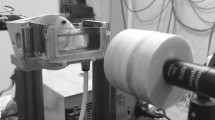Abstract
Purpose
To develop a novel automated three-dimensional (3D) laser drilling algorithm to further investigate laser–stone interaction with different laser pulse modes. Comparison of post-ablative lattice architecture combined with mass of stone ablated can provide a more complete understanding of differences between pulse mode.
Methods
A 3D positioner (securing laser fiber) was programmed to create a 5 × 5 grid of drill holes spaced 1 mm apart on 15:5 cylindrical BegoStones. Beginning 0.5 mm above the stone surface, the laser fiber was activated and advanced 2 mm toward and into the stone for all 25 points. Four trials for each pulse mode [short pulse (SP), long pulse (LP), Moses Contact (MC), Moses Distance (MD)] were completed. Outcome measures were assessment of lattice preservation and mass of ablated stone.
Results
MC exhibited the greatest lattice preservation and least stone mass ablated (50.5 ± 2.2 mg). SP (69.4 ± 4.3 mg) and MD (70.0 ± 2.6 mg) had the greatest lattice destruction and stone mass ablated. The differences in stone ablated between MC and MD (p = 0.00003), MC and SP (p = 0.0002), and LP and MD (p = 0.004) were statistically significant.
Conclusions
Consistent quantitative and qualitative differences between pulse modes were observed with a novel automated 3D laser drilling algorithm applied to BegoStone. The laser drilling algorithm developed here can be used to further enhance mechanistic understanding of laser–stone interactions and facilitate selection of appropriate laser pulse modes to balance precision and efficiency across the range of laser lithotripsy techniques.



Similar content being viewed by others
References
Matlaga BR et al (2018) Ureteroscopic laser lithotripsy: a review of dusting vs fragmentation with extraction. J Endourol 32(1):1–6. https://doi.org/10.1089/end.2017.0641
Dauw CA et al (2015) Contemporary practice patterns of flexible ureteroscopy for treating renal stones: results of a worldwide survey. J Endourol 29(11):1221–1230. https://doi.org/10.1089/end.2015.0260 (Mary Ann Liebert Inc.)
Aldoukhi AH, Roberts WW, Hall TL, Ghani KR (2019) Watch your distance: the role of laser fiber working distance on fragmentation when altering pulse width or modulation. J Endourol 33(2):120–126. https://doi.org/10.1089/end.2018.0572
Fried NM, Irby PB (2018) Advances in laser technology and fibre-optic delivery systems in lithotripsy. Nat Rev Urol 15(9):563–573. https://doi.org/10.1038/s41585-018-0035-8
Sroka R et al (2015) Impact of pulse duration on Ho:YAG laser lithotripsy: treatment aspects on the single-pulse level. World J Urol 33(4):479–485. https://doi.org/10.1007/s00345-015-1504-9
Ventimiglia E, Doizi S, Kovalenko A, Andreeva V, Traxer O (2020) Effect of temporal pulse shape on urinary stone phantom retropulsion rate and ablation efficiency using holmium: YAG and super-pulse thulium fibre lasers. BJU Int 126(1):159–167. https://doi.org/10.1111/bju.15079
Wollin DA et al (2017) Variable pulse duration from a new Holmium: YAG laser: the effect on stone comminution, fiber tip degradation, and retropulsion in a dusting model. Urology 103:47–51. https://doi.org/10.1016/j.urology.2017.01.007
Wezel F, Häcker A, Gross AJ, Michel MS, Bach T (2010) Effect of pulse energy, frequency and length on holmium: yttrium-aluminum- garnet laser fragmentation efficiency in non-floating artificial urinary calculi. J Endourol 24(7):1135–1140. https://doi.org/10.1089/end.2010.0115
De Coninck V et al (2019) Ho:YAG laser lithotripsy in non-contact mode: optimization of fiber to stone working distance to improve ablation efficiency. World J Urol 37(9):1933–1939. https://doi.org/10.1007/s00345-018-2589-8
Elhilali MM, Badaan S, Ibrahim A, Andonian S (2017) Use of the Moses technology to improve holmium laser lithotripsy outcomes: a preclinical study. J Endourol 31(6):598–604. https://doi.org/10.1089/end.2017.0050
Hecht SL, Wolf JS (2013) Techniques for holmium laser lithotripsy of intrarenal calculi. Urology 81(2):442–445. https://doi.org/10.1016/j.urology.2012.11.021
Aldoukhi AH, Black KM, Ghani KR (2019) Emerging laser techniques for the management of stones. Urol Clin North Am. https://doi.org/10.1016/j.ucl.2018.12.005
Chen J et al (2021) Cavitation plays a vital role in stone dusting during short pulse Holmium: YAG Laser Lithotripsy. J Endourol 919:1–28. https://doi.org/10.1089/end.2021.0526
Keller EX, De Coninck V, Doizi S, Daudon M, Traxer O (2020) What is the exact definition of stone dust? An in vitro evaluation. World J Urol 39(1):187–194. https://doi.org/10.1007/s00345-020-03178-z
Funding
Funding for this research was provided through a research grant from Boston Scientific.
Author information
Authors and Affiliations
Contributions
NRK: data collection, data analysis, manuscript writing and editing. TLH: manuscript writing and editing. KRG: manuscript writing and editing. WWR: project development, data analysis, manuscript writing and editing.
Corresponding author
Ethics declarations
Conflict of interest
N Rezakahn Khajeh, and TL Hall have no disclosures. KR Ghani has consulting relationships with Boston Scientific, Lumenis, Olympus, Coloplast, and Karl Storz. WW Roberts has a consulting relationship with Boston Scientific.
Human or animal participants
This research did not involve human or animal participants.
Informed consent
Therefore, informed consent was not required.
Additional information
Publisher's Note
Springer Nature remains neutral with regard to jurisdictional claims in published maps and institutional affiliations.
Rights and permissions
Springer Nature or its licensor holds exclusive rights to this article under a publishing agreement with the author(s) or other rightsholder(s); author self-archiving of the accepted manuscript version of this article is solely governed by the terms of such publishing agreement and applicable law.
About this article
Cite this article
Rezakahn Khajeh, N., Hall, T.L., Ghani, K.R. et al. Development of an automated laser drilling algorithm to compare stone ablation patterns from different laser pulse modes. World J Urol 40, 2701–2705 (2022). https://doi.org/10.1007/s00345-022-04148-3
Received:
Accepted:
Published:
Issue Date:
DOI: https://doi.org/10.1007/s00345-022-04148-3




